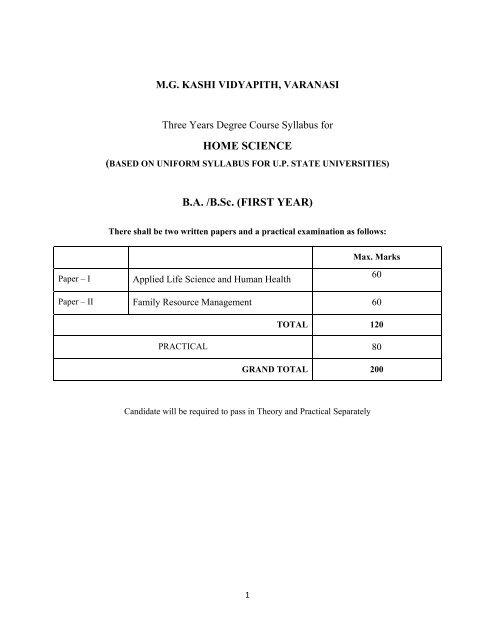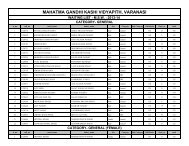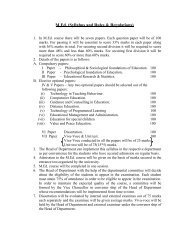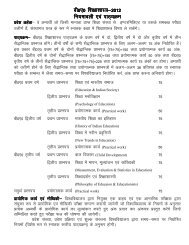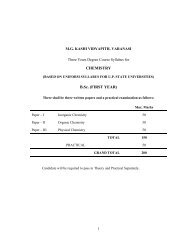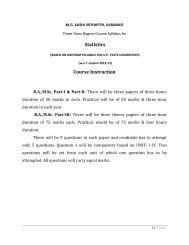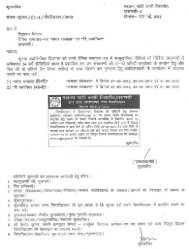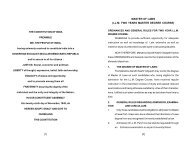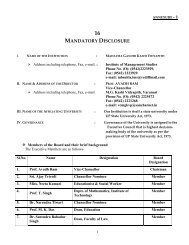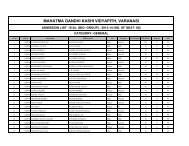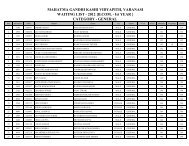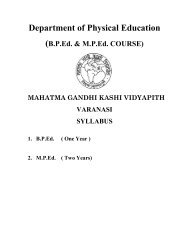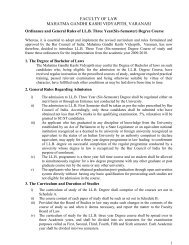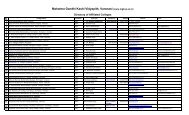home science - Mahatma Gandhi Kashi Vidyapith University
home science - Mahatma Gandhi Kashi Vidyapith University
home science - Mahatma Gandhi Kashi Vidyapith University
Create successful ePaper yourself
Turn your PDF publications into a flip-book with our unique Google optimized e-Paper software.
M.G. KASHI VIDYAPITH, VARANASIThree Years Degree Course Syllabus forHOME SCIENCE(BASED ON UNIFORM SYLLABUS FOR U.P. STATE UNIVERSITIES)B.A. /B.Sc. (FIRST YEAR)There shall be two written papers and a practical examination as follows:Max. MarksPaper – IApplied Life Science and Human Health60Paper – II Family Resource Management 60TOTAL 120PRACTICAL 80GRAND TOTAL 200Candidate will be required to pass in Theory and Practical Separately1
Three Years Degree Course Syllabus forHOME SCIENCE(BASED ON UNIFORM SYLLABUS FOR U.P. STATE UNIVERSITIES)B.A. /B.Sc. (SECOND YEAR)There shall be two written papers and a practical examination as follows:Max. MarksPaper – IFundamentals of Food and Nutrition60Paper – II Child Development 60TOTAL 120PRACTICAL EXAMINATION 80GRAND TOTAL 200Candidate will be required to pass in Theory and Practical Separately5
Objectives:B.A. /B.Sc. (SECOND YEAR)HOME SCIENCEPaper I: Fundamental of Food and NutritionM.M. - 60This course will enable the student to1. Understand the functions of food and the role of various nutrients, their requirementsand effects of deficiency and excess (in Brief)2. Learn about the structure, composition, nutritional contribution and selection ofdifferent food stuffs.3. Be familiar with the different methods of cooling, their advantages anddisadvantages.4. Develop an ability to improve the nutritional quality of food.5. To get acquainted to the terms like food poisoning and food adulteration.Unit-IIntroduction to Food and Nutrition1. Definition of foods, Nutrition, Nutrients.2. Classification and function of food.3. Energy- Factors affecting total energy requirements of the body.4. Basal metabolism- Definition, Factors affecting rate of B. M.R.5. Balanced diet and factors affecting balanced diet.Unit- IIEssential constituents of Food: Protein, Carbohydrate, Fat, Vitamins, Minerals, Water theirsources, functions, requirements, absorption and deficiency diseases. Digestion and Absorption ofMajor Nutrients.Basic Food Groups, Importance of basic food groups in the diet. Nutrient, contribution of foodstuffs and their importance in Indian diets like cereals, pulses, nuts, and oilseeds, vegetables,fruits, milk and milk products, egg, meat, fish, fats and oils, sugar and jaggery, spices andcondiments.Unit – IIINutrition during lifecycle:Nutrition during infancy, Nutrition during Childhood, Nutrition for adolescence, Nutrition foradults, Nutrition during old age, Nutrition during pregnancy and lactation.Unit – IVDietary allowances: Meal planning, features affecting meal planning.Various cooking methods and their effect on the nutritional value of various nutrients.Food adulteration- Meaning and common adulterants in food, Food poisoning.References:1. Dietetics: B.Shrilakshmi2. Normal and Therapeutic Nutrition: Proudifit and Robinson.3. Essentials of Food and Nutrition (Vol. I and Vol. II): M. Swaminathen.4. Applied nutrition: Rajlakshmi.5. Human Nutrition and Dietetics: Davidson and Passmore6
B.A. /B.Sc. (SECOND YEAR)HOME SCIENCEPaper II: Child DevelopmentM.M. - 60Objectives: This course will enable the students to:1. Understand the meaning and importance of mother crafts and child care.2. Understand the definition and scope of child development3. Understand various developments like physical, motor, emotional, language, socialand cognitive from birth to adolescence.4. Understand the importance of play.5. Understand gifted children and problem children and concept of juveniledelinquency.Unit IIntroduction to Child Development 1. Definition and scope of child development.2. Principles of development.3. Stages of development and development task of each stage.4. Factors affecting development.Unit- IIPrenatal Period 1- Meaning and importance of mother craft and child care.2- Female reproduction organs (Internal).3- Conception and signs of pregnancy complications of pregnancy. Hyperemsis gravitarum Abortions Toxemia of Pregnancy R.H. Factor Anemia1. Stages of prenatal development zygote, embryonic and neonatal stages.2. Types of deliveryUnit- IIIDevelopment and Growth with Characteristics from birth to adolescence1. Physical development2. Motor development3. Emotional development4. Language development5. Social development6. Cognitive development.Unit- IVPlay and work- Types of play, Importance of playPersonality- Meaning, development and features affecting personality.Exceptional Children (gifted)Problem children- Factor affecting their behavior and methods for correction.Juvenile delinquencyMeaning, causes and treatment.References:1. Child Development: Elizabeth Hurlock.2. Child Development: Dr. Vatseyan3. Child Development and Personality: P.Mussen, J.J.Conger, J. Kagan and A.C. Huston7
B.A. /B.Sc Part II (Home Science)(Practical)M.M.-80Marks Allotment:Unit-I1. Nutrition during infancy (0-1).2. Nutrition during preschool (up 3 years)3. Nutrition during school going child with special emphasis on packed lunch.4. Nutrition during adolescence.5. Nutrition during adulthood (Men and Women). Sedentary work Moderate work Heavy work6. Nutrition during old age.7. Nutrition during Pregnancy8. Nutrition during lactationUnit- IISessional work1. Recipe file2. Menu planning note book3. Preparation of an educational/ recreational material for children (age up to 5 years)Meal Planning 16Cooking & serving 20Prepare Resource Material for Preschool Child 16Viva- voce 8Sessional work 20Total Marks 808
Three Years Degree Course Syllabus forHOME SCIENCE(BASED ON UNIFORM SYLLABUS FOR U.P. STATE UNIVERSITIES)B.A. /B.Sc. (THIRD YEAR)There shall be two written papers and a practical examination as follows:Max. MarksPaper – IIntroduction to Textiles and Clothing100Paper – II Extension Education 100TOTAL 200PRACTICAL EXAMINATION 100GRAND TOTAL 300Candidate will be required to pass in Theory and Practical Separately9
Focus:Objective:References:B.A. /B.Sc. (THIRD YEAR)HOME SCIENCEPaper I: Introduction to Textiles and Clothing M.M. – 100Variety in clothing depends on variety in textiles/ their performance is also varying. It isessential for a student to have some basic knowledge of these textiles to select the rightkind of fabric for a specific use. Clothing is important for protection, comfort, personalityand growth in relevant age group.To enable students to-1. Acquainted with the different textiles and their performances.2. Impart knowledge on different textile finishes.3. To acquaint with proper notion regarding choice of fabric.4. To develop skills in clothing construction.Unit –ITextiles1. Introduction to textiles.2. Classification to textile fibers.3. Manufacture, Properties, and uses of – cotton, linen, wool, silk, rayon, polyamide andacrylic fibers.4. Identification of textile fiber.Study of Yarns1. Yarn construction. 2. Different types of yarns.Unit –IIWeaving1. Weaving process- To study the parts and functions of a loom.2. Different types of basic and decorative weaving.Finishes1. Physical – singeing, napping, brushing, shearing, sizing, shrinking, tendering andcalendaring.2. Chemical- bleaching and mercerizing3. Special Purpose finishes- wrinkle resistant, water repellent, flame retardant, dyingand printing etc.Unit- IIIEquipment for clothingEquipment and supplies used in clothing construction with special reference to sewing machine.Selection of fabricFactors influencing selection of fabric, budget, age, season, occupation, figure, fashion, occasion etc.Unit- IVPrinciple of clothing construction1. General principles of clothing construction.2. Drafting and making paper pattern.3. Preparation of fabrics for garment making, laying out of patterns, cutting and making.1. Textile Fabrics and Their Selection: Wingate.2. Textiles: Hollwn and Saddler.3. Textile Fiber and their use: Katharine Paddoek Hess.4. Art of Sewing: Anna Jacob.5. Manual for Children Clothing:Savitri Pandit.6. Basic Process and Clothing Construction:Sherie Doonyaji and Raushni Desh Pandey.7. Fundamentals of Textiles and Their Care: Susheela Dantyagi.8. Household Textiles and Laundry Work: Durga Deulkar.10
Focus:Objectives:References:B.A. /B.Sc. (THIRD YEAR)HOME SCIENCEPaper II: Extension EducationM.M. – 100The concept of development is changing. It is not merely increase in production andproductivity, but also it is participation of people in mutual learning experience involvingthemselves, their local resources, external changes agents and outside resources. The actof extension is not merely transference of techniques and knowledge but it involvesimproving of relationships between human beings.To enable students to-1. Understand the widening concept of extension.2. Be aware of the various extension methods used in facilitating development.3. Feel strongly for the people without power and influence then to become partners indevelopment projects and programs.Unit-IConcept of Extension EducationMeaning of Extension Education.Origin and wider understanding of the meaning of extension.Definition, Importance and Scope of Home Science Extension education.Principles and Philosophy of Extension Education.Unit-IIMethods of Approaching People1. Personal Approach2. Group Approach.3. Mass Approach.Communication1. Definition and importance of communication.2. Functions of Communication.3. Problems of Communication.Unit-IIIExtension workRole of an extension worker, Quality of an extension worker.Audio Visual AidsDetailed knowledge of audio visual aids.Unit- IVProblems regarding extension education in the community,Extension of Program PlanningExtension program planning in the various fields of Home <strong>science</strong>.1. Extension and Rural Welfare: O.P.Dahama2. Community Development Programs in India: Ministry of Child Development11
Allotment of Marks:1. Tie and Dye.B.A. /B.Sc Part III (Home Science)(Practical)2. Block printing or screen/ Stencil Printing.3. (a)To prepare a paper pattern of child’s bodice block (3 years old).(b)Adaptation of child’s bodice block to an ‘A’ line Frock.4. Preparation of Audiovisual Aid (any one )(a) Poster and Chart(b) Flash card or Flip book(c) Puppet5. Viva Voce6. Sessional Work(a) One Tie and Dye article(b) One article with block printing(c) One article with Screen/Stencil printing(d) Stitch one ‘A’ line Frock (3year old)a. Any Two: 14+14• Tie and Dye:• Block Printing:• Stencil printing:b. Paper pattern Basic bodice Block: 14c. Audio Visual aid: 14d. Viva Voce: 14e. Sessional: 30TOTAL 10012


